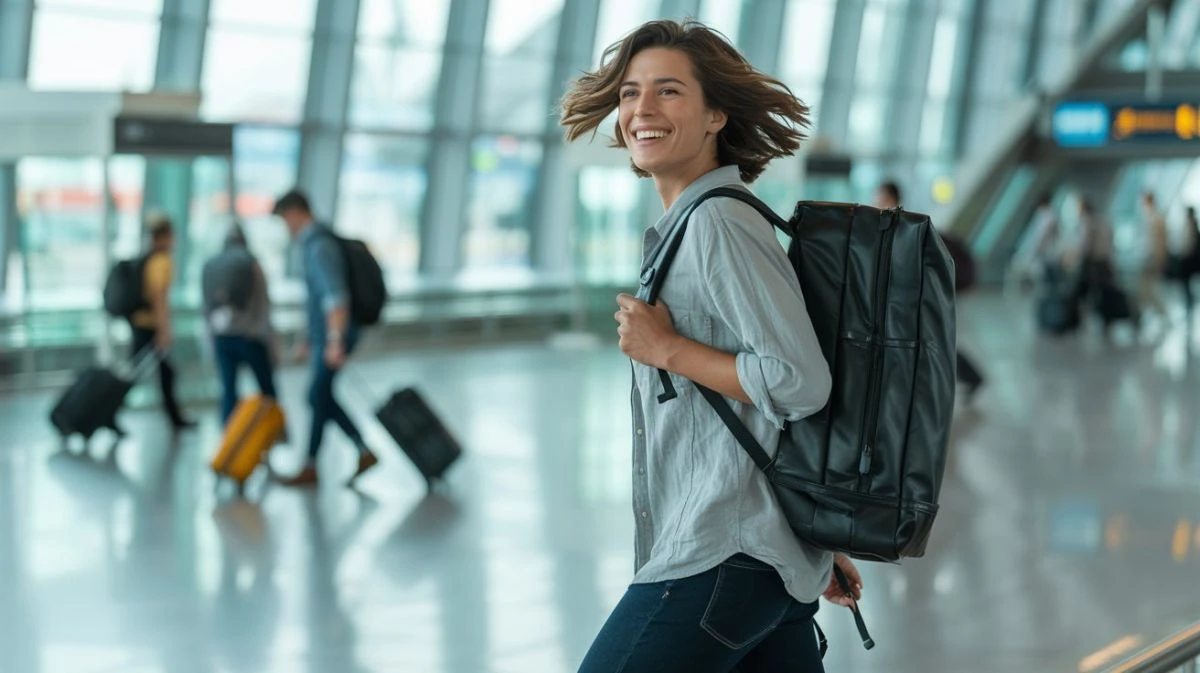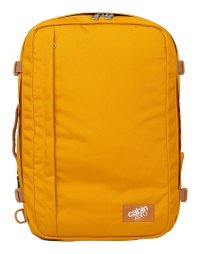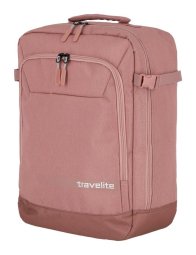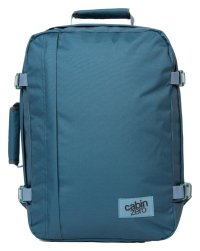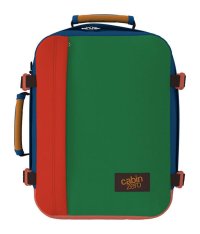Imagine you're getting ready for a holiday. Instead of struggling with a heavy suitcase at the airport, you confidently walk through with a backpack on your back. Your travel backpack is your only companion, and you know you can go anywhere with it – no check-in queues, no fear of losing it, and no unnecessary fees. Welcome to a world where the cabin backpack as a suitcase alternative is not just a comfortable choice, but a revolutionary approach to travel. In our guide, you'll find out why more and more people are opting for a carry-on backpack instead of a suitcase and how to choose the right one to become your reliable travel partner.
Contents:
- Why is the cabin backpack a revolution in travel?
- 7 key advantages that cabin backpacks offer you
- How to choose the ideal cabin backpack, not just for the plane?
- Packing efficiently: Tips and tricks for making the most of cabin backpacks
- With a cabin backpack: safely and without surprises at the airport
- When to give the suitcase another chance? Backpack versus travel suitcase
- Frequently asked questions about cabin backpacks
- The airplane backpack as a symbol of freedom
Why is the cabin backpack a revolution in travel?
In recent years, the travel habits of many people have changed significantly. With the rise of low-cost airlines, travelling with a backpack has become not only a symbol of minimalism and freedom but also a necessary strategy to avoid additional baggage fees. Cabin suitcases seem convenient, but their fixed dimensions and limited flexibility sometimes become a problem at the airport and beyond. Imagine trying to squeeze through a crowded tram with a suitcase, or dragging it up the stairs in a hotel without a lift. With a cabin backpack, you simply avoid these situations. Your travel backpack for the plane becomes a part of your body, allowing you to easily manoeuvre through crowds and get to places you simply can't with a suitcase. It's about freedom of movement, efficiency, and the fact that travel should be as comfortable as possible, not restrictive.
7 key advantages that cabin backpacks offer you
When we talk about the cabin backpack being a great choice, we're not just talking hot air. Here are 7 main reasons why you should consider switching from a suitcase to a backpack.
- Free hands, easy movement: One of the biggest advantages is that your hands are free. You can buy a coffee, type on your mobile, or hold a map without having to worry about a wheeled suitcase. At the airport, on the bus, at the station – you move much more nimbly everywhere.
- Flexibility of size and money savings: Unlike a rigid suitcase, a travel backpack can adapt to the luggage space. Compression straps allow you to reduce its volume to fit into the special frame – the size checker for carry-on luggage at the airport. With low-cost airlines like Ryanair or Wizz Air, this is a key factor that will save you tens of euros in fees.
- Greater organisation and clarity: Modern travel backpacks are designed with maximum emphasis on organisation. They offer special compartments for a laptop, tablet, documents, and plenty of other pockets to keep your things neatly organised.
- Durability on rough terrain: With a backpack, you don't have to worry about uneven terrain, cobblestones, or dirt tracks. Where the wheels of a suitcase would get stuck or damaged, you can still carry the backpack comfortably on your back.
- Comfortable to carry: A quality cabin backpack with an ergonomic back system and padded shoulder straps distributes the weight evenly on your back, significantly reducing the strain on your spine and shoulders.
- Versatility of use: While you won't use a suitcase much in everyday life, you can take a travel backpack on shorter trips, to work, to school, or on day trips.
- Minimalism as a lifestyle: Travelling with a backpack naturally forces you to think about what you pack and what you really need. This leads to efficient packing and cheaper travel, which is a big plus for many travellers.
How to choose the ideal cabin backpack, not just for the plane?
Choosing a travel backpack for the plane is not rocket science, but it pays to pay attention. It's important to focus on a few key parameters.
Dimensions and volume: The key to success
Most airlines have their own rules for the dimensions of carry-on luggage. For example, Ryanair allows dimensions of 40x20x25 cm for a small personal item. Backpacks that are designed to meet these standards are an ideal choice. Don't forget about the volume, which usually ranges between 20-40 litres.
Tip: You can find a clear table with the dimension limits for carry-on luggage of individual airlines in a separate article.
Tip: For clarity, we have divided the travel backpacks in our offer by dimensions, so you can find the exact backpack that meets the conditions according to your airline's limits: backpacks for the plane 40x20x25, backpacks for the plane 40x30x20, and backpacks for the plane 55x40x20.
Construction and comfort: Back system and straps
- Back system: It should be padded and breathable to prevent sweating.
- Shoulder straps: They should be padded and ideally adjustable.
- Chest and hip strap: These straps help to distribute the weight and ensure comfortable carrying even with a heavier load.
Material and durability: A durable backpack is an investment
The material the backpack is made of determines its lifespan. Look for backpacks made from durable and water-resistant materials such as Cordura or ripstop nylon. Quality zips are also important.
Practical features and compartments
- Laptop compartment: Ideal for digital nomads. Look for padded pockets and check that your laptop fits.
- External pockets: For documents, a water bottle, or an umbrella. Hidden pockets and quick-access pockets can be useful without having to take the backpack off your back.
- Trolley sleeve: Thanks to the sleeve on the back panel, the backpack can be comfortably carried on a travel suitcase or a bag with a retractable handle.
Packing efficiently: Tips and tricks for making the most of cabin backpacks
Organising a travel backpack is an art worth mastering. Packing efficiently will allow you to take much more with you than you'd expect.
- Rolling and folding technique: You can roll or fold your clothes using the "folding" method, which minimises creases and saves space.
- Use of organisers and smaller pouches and cases: Cases for electronics or toiletry bags will ensure you don't have to rummage through the whole backpack for every little thing. You can also use travel organisers (packing cubes), which will keep everything in its place and allow you to get an overview of your backpack.
How to organise your things in your backpack:
- Heavy items at the bottom: First, put the heaviest items at the bottom, such as shoes or a wash bag.
- Laptop as close to the back as possible: Use the padded compartment designed for carrying a laptop.
- Clothes in the middle: Use travel organisers or compression bags and place the clothes in the middle of the backpack.
- Small items and documents at the top: Put important small items like documents, phone, and a snack in easily accessible, possibly separate pockets to keep them handy.
- Long trips or family holidays: If you are travelling for a longer period and need more clothes, a suitcase with a larger volume (travel suitcases M / travel suitcases L) may be more practical.
- Transporting fragile or valuable items: The hard shell of a suitcase provides better protection for expensive gifts, electronics, or other fragile items.
- Business travel: For business trips where you need to have perfectly packed suits or dresses and a professional image is important, the suitcase is still the most commonly used choice.
Tip: Practical and elegant laptop suitcases are perfect for business trips! - What are the advantages of a cabin backpack over a suitcase?
A cabin backpack offers greater flexibility and convenience, especially when travelling with low-cost airlines. You can easily take it on board the plane with you, which saves time and makes it easier to access important items during the flight. - What size does a cabin backpack need to be?
Each airline has its own requirements for the dimensions of carry-on luggage. Usually, the dimensions are around 55 x 40 x 20 cm, but it's a good idea to check the specific requirements of your airline to avoid problems when boarding. - What is the ideal volume for a cabin backpack?
The ideal volume for a cabin backpack is around 25-45 litres, which is enough for shorter trips. For longer trips, you might consider a suitcase on wheels, a travel bag, or a hiking rucksack. However, bear in mind the need to check it in. - How do I pack a cabin backpack properly?
When packing a cabin backpack, it's a good idea to organise your things into individual compartments and pockets. This will ensure you have easy access to important items like your laptop or documents. - Are cabin backpacks comfortable to carry?
Yes, most cabin backpacks are equipped with ergonomic shoulder straps and harnesses, which ensures comfortable carrying. When choosing a backpack, it's a good idea to try it on to see how it fits on your back and whether it meets your comfort requirements.
With a cabin backpack: safely and without surprises at the airport
One of the biggest stress factors when travelling is the fear that your luggage won't fit within the permitted dimensions. With a cabin backpack, you can avoid this risk if you check the rules of the specific airlines beforehand.
Tip: Find out all about cabin, personal, and checked luggage in a separate article in our guide.
TSA locks and security checks
If your backpack has a TSA lock, it will make it easier for you to get through security, where authorities can open the luggage without damaging the lock.
Tip: A padlock-style TSA lock can also be bought separately to further secure your backpack by locking the zip pullers.
It's also important to remember the rules for transporting liquids. These must be placed in a transparent bag with a maximum volume of 1 litre. No single bottle may exceed 100 ml.
Tip: We have discussed everything you can and can't take with you on board a plane in a separate article.
When to give the suitcase another chance? Backpack versus travel suitcase
Although the cabin backpack offers countless advantages, there are situations where a cabin suitcase is still a better choice. It's important to realise that not every type of travel is suitable for a backpack.
Frequently asked questions about cabin backpacks
The airplane backpack as a symbol of freedom
Our journey to discover the cabin backpack as a suitcase alternative has shown that it is a modern, flexible, and efficient way to travel. It promises free hands, comfort on the move, and above all, savings on airport fees. While the cabin suitcase has its place, the travel backpack for the plane is the clear winner for anyone who wants to travel smart and light. Choose the right one at Bagalio.eu, pack up, and set off on your journey!
Whether you choose a travel backpack or a cabin suitcase, the most important thing is to enjoy your travels to the full. We hope this guide has helped you to clarify what is best for you, and that you will look forward to every future trip you take!

